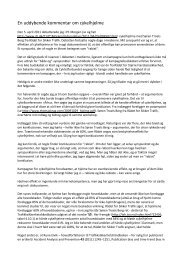Cykling, motion, miljø og sundhed - Thomas Krag
Cykling, motion, miljø og sundhed - Thomas Krag
Cykling, motion, miljø og sundhed - Thomas Krag
You also want an ePaper? Increase the reach of your titles
YUMPU automatically turns print PDFs into web optimized ePapers that Google loves.
The results are robust towards changes of direct investment in bicycle infrastructure and<br />
campaigning and the effects from this, while the value of the health and consumer advantages has a<br />
larger influence, t<strong>og</strong>ether with the relationship between car, public transport, walking, and<br />
bicycling.<br />
Cities with special cycle-initiatives<br />
In addition to all this, we have described 9 cases – three concerning Danish cities/regions, and 6<br />
concerning foreign cities/regions – where special initiatives have been taken to promote cycling.<br />
The case studies show that there are many different factors that may successfully contribute to<br />
increasing cycling. Among these are:<br />
• A strong political commitment to increase cycling<br />
• Enthusiastic and committed civil servants and officials who can support concrete projects<br />
with political accept<br />
• The existence of regional funding or road user charge funds that can finance local cycleinitiatives<br />
• The implementation of concrete plans, and long term commitment to these plans<br />
Moreover, focus on cycling, as a means to reduce both traffic congestion and health problems<br />
seems to be increasing. Improving traffic safety is not the main argument anymore for engaging in<br />
the issue of cycling.<br />
Recommendations<br />
In light of the analyses it is recommended that:<br />
• Cycling must have higher priority in campaigns promoting physical exercise for children and<br />
adults.<br />
• The Ministry of Traffic t<strong>og</strong>ether with The Ministry of Health and the Ministry of Environmental<br />
Affairs must be involved in the realization of projects to increase physical exercise.<br />
• A concrete plan must be formulated, detailing how children can be urged to cycle more. This<br />
must include tightening traffic regulations and speed control near schools, sports centers, and<br />
other places frequented by children.<br />
• A plan must be formulated to reduce air pollution, especially in the form of ultra fine particles,<br />
in cities, in order to provide a safer environment for the cyclists.<br />
• National funding must be reintroduced. These funds should be earmarked, so that municipalities<br />
interested in running cycle campaigns, developing bicycle infrastructure, and improving safety<br />
can apply for financial resources to do so.<br />
• Cycling campaigns and communication of knowledge on how cycling can be increased should<br />
be centrally coordinated.<br />
• Danish calculations must be made of the economical benefits of increasing physical exercise,<br />
including cycling.<br />
• Future economical analyses concerning traffic should include effects on cycling and<br />
walking, and indirect consequences for public health. Such calculations should also influence<br />
whether traffic projects are prioritized in governmental strategies concerning the environment.<br />
- 15 -



